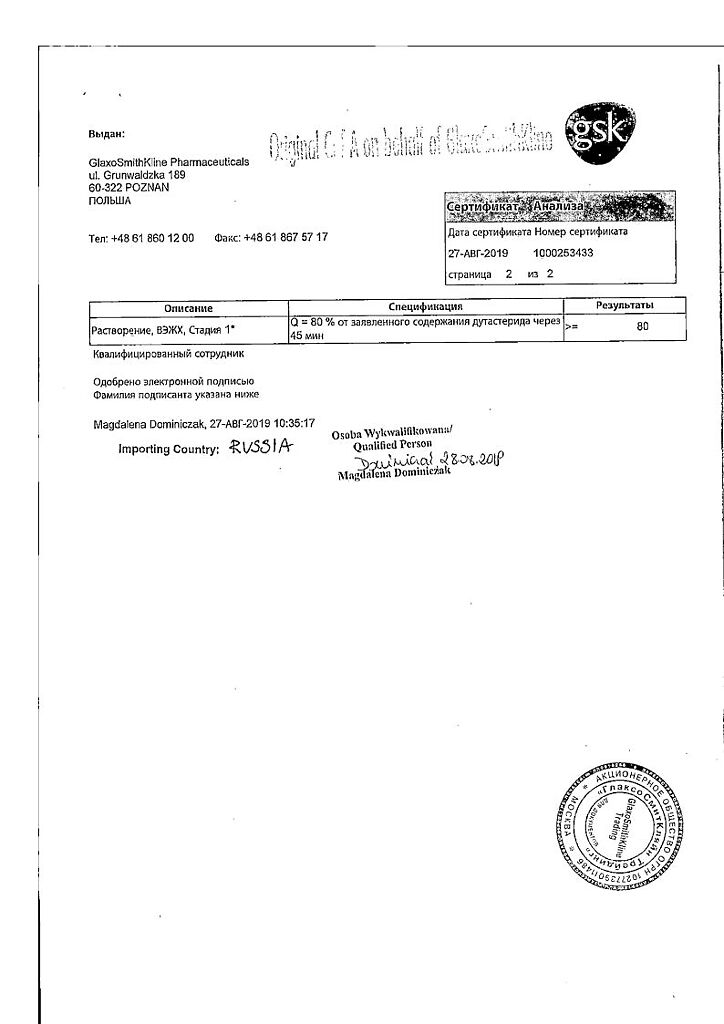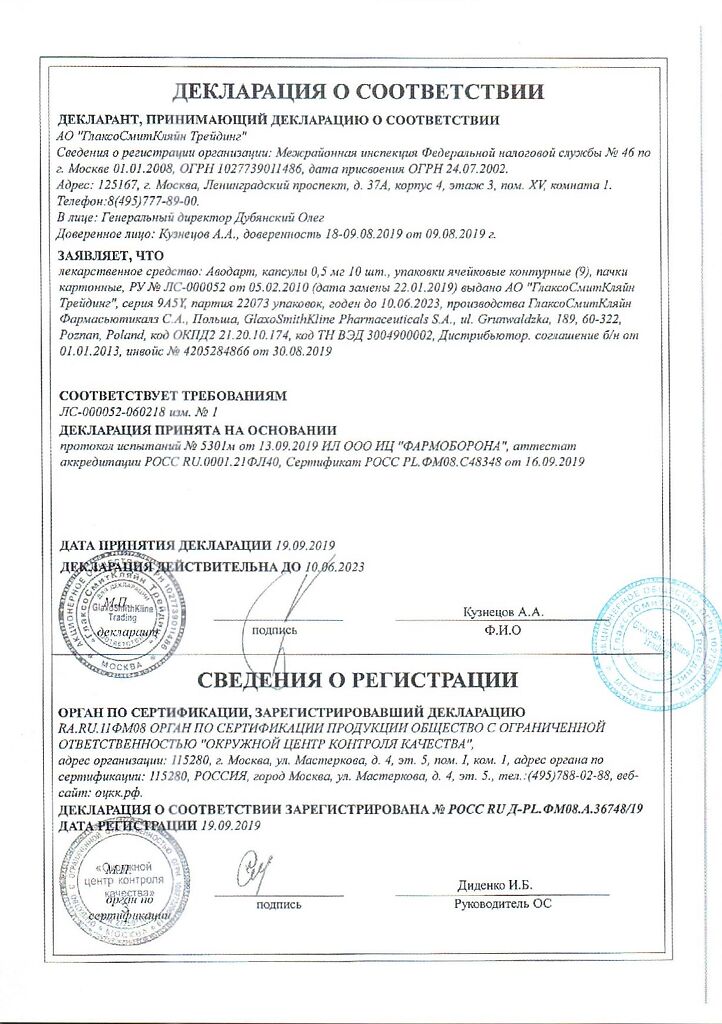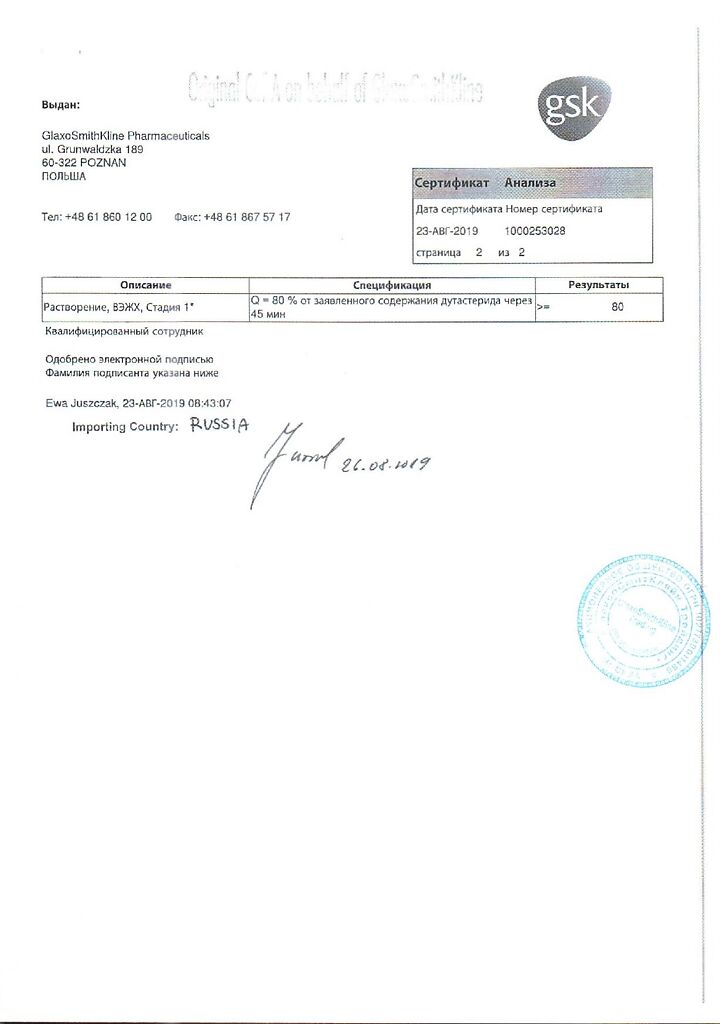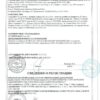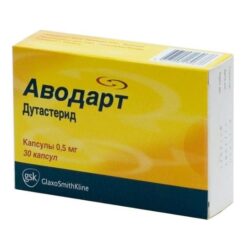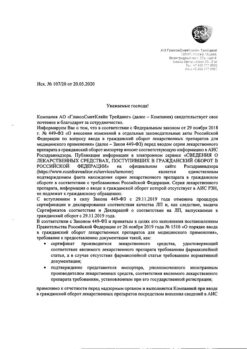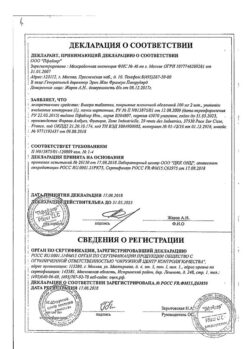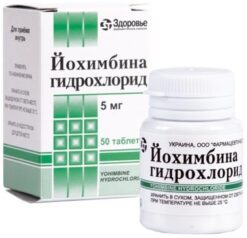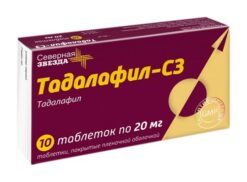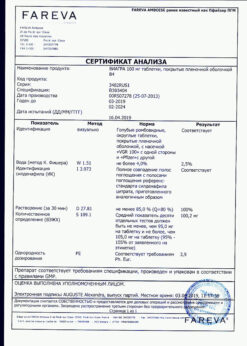No products in the cart.
Avodart, 0.5 mg capsules 90 pcs
€125.82 €119.85
Description
Pharmacological action Pharmacological action – antiandrogenic.
Pharmacodynamics
Dutasteride is a double inhibitor of 5α-reductase. Inhibits the activity of 5α-reductase type 1 and 2 isoenzymes, which are responsible for the conversion of testosterone to dihydrotestosterone (DHT). DHT is the main androgen responsible for glandular hyperplasia in the prostate gland.
The effect on DHT and testosterone concentrations. The maximum effect of dutasteride on reduction of DHT concentration is dose-dependent and is observed 1-2 weeks after the start of treatment. After 1 and 2 weeks of dutasteride at a dose of 0.5 mg/day, the average values of serum DHT concentrations are reduced by 85 and 90%, respectively.
Pharmacokinetics
Intake
After a single dose of 0.5 mg, the Tmax of dutasteride in serum is 1-3 hrs.
The absolute bioavailability of dutasteride in males is approximately 60% relative to a 2-hour IV infusion. The bioavailability of dutasteride is independent of food intake.
Distribution
Pharmacokinetic data obtained after single and multiple doses of dutasteride indicate a large Vd (300 to 500 L). Dutasteride has a high degree of binding to plasma proteins (>99.5%).
When taken daily, the serum concentration of dutasteride reaches 65% of the stable level after 1 month and approximately 90% of that level after 3 months. Stable serum concentrations of dutasteride (ss) of approximately 40 ng/mL are achieved after 6 months of daily administration of 0.5 mg of the drug. In sperm, as well as in serum, stable concentrations of dutasteride are also achieved after 6 months. After 52 weeks of treatment, dutasteride concentrations in sperm averaged 3.4 ng/ml (0.4 to 14 ng/ml). Approximately 11.5% of dutasteride was transferred from serum to sperm.
Metabolism
In vitro, dutasteride is metabolized by the human cytochrome P450 system CYP3A4 isoenzyme to two small monohydroxylated metabolites; However, it is not affected by the CYP1A2, CYP2A6, CYP2E1, CYP2C8, CYP2C9, CYP2C19, CYP2B6 or CYP2D6 isoenzymes of this system. After achieving stable serum concentrations of dutasteride, unchanged dutasteride, 3 major metabolites (4′-hydroxydutasteride, 1,2-dihydrodutasteride and 6-hydroxydutasteride) and 2 minor metabolites (6,4′-dihydroxydutasteride and 15-hydroxydutasteride) are detected by mass spectrometric method. </Excretion
Dutasteride undergoes intensive metabolism in the human body. After oral administration of dutasteride at a dose of 0.5 mg/day until a stable concentration is reached, 1 to 15.4% (5.4% on average) of the dose taken is excreted through the intestine unchanged. The remainder is excreted through the intestine as 4 major metabolites, accounting for 39, 21, 7, and 7%, respectively, and 6 minor metabolites (each accounting for less than 5%).
Only trace amounts of unchanged dutasteride (less than 0.1% of the dose) are excreted through the kidneys in humans.
Therapeutic doses of dutasteride have a final T1/2 of 3-5 weeks.
Dutasteride is detectable in serum (in concentrations above 0.1 ng/ml) up to 4-6 months after discontinuation.
Linearity/nonlinearity
The pharmacokinetics of dutasteride can be described as a first-order absorption process and two parallel elimination processes, one saturable (i.e., concentration-dependent) and one unsaturated (i.e., concentration-independent). At low serum concentrations (less than 3 ng/ml), dutasteride is rapidly eliminated by both elimination processes. After a single dose of 5 mg or less, dutasteride is rapidly eliminated from the body and has a short T1/2 of 3-9 days.
At serum concentrations above 3 ng/ml, dutasteride is eliminated more slowly (0.35-0.58 L/h), primarily via a linear, unsaturated elimination process, with a final T1/2 of 3-5 weeks. At therapeutic concentrations, the final T1/2 is 3-5 weeks, and a slower clearance of dutasteride predominates with daily administration of 0.5 mg; overall clearance is linear and concentration-independent. Serum levels of dutasteride (greater than 0.1 ng/mL) are detectable for 4-6 months after discontinuation of treatment.
Elderly men
The pharmacokinetics and pharmacodynamics of dutasteride were studied in 36 healthy men aged 24 to 87 years after a single dose (5 mg) of the drug. There were no statistically significant differences between the different age groups in such pharmacokinetic parameters as AUC and Cmax. There were also no statistically significant differences in T1/2 values of dutasteride between the age groups of men 50-69 years old and over 70 years old, which include most men with BPH.
There were no significant differences between the different age groups in the degree of reduction of DHT levels. These results demonstrate that there is no need to reduce the dose of dutasteride depending on the age of patients.
Indications
Indications
As monotherapy:
– treatment and prevention of the progression of benign prostatic hyperplasia by reducing the size of the prostate gland, improving urination, reducing the risk of acute urinary retention and the need for surgical intervention.
As a combination therapy with α1-blockers:
– treatment and prevention of the progression of benign prostatic hyperplasia by reducing the size of the prostate gland, improving urination, reducing the risk of acute urinary retention and the need for surgical intervention. The combination of dutasteride and the α1-blocker tamsulosin was mainly studied.
Pharmacological effect
Pharmacological effect
Pharmacological action
Pharmacological action – antiandrogenic.
Pharmacodynamics
Dutasteride is a dual 5α-reductase inhibitor. Suppresses the activity of 5α-reductase isoenzymes types 1 and 2, which are responsible for the conversion of testosterone to dihydrotestosterone (DHT). DHT is the main androgen responsible for prostate hyperplasia.
Effect on the concentration of DHT and testosterone. The maximum effect of dutasteride on reducing DHT concentrations is dose-dependent and is observed 1–2 weeks after the start of treatment. After 1 and 2 weeks of taking dutasteride at a dose of 0.5 mg/day, mean serum DHT concentrations decreased by 85 and 90%, respectively.
Pharmacokinetics
Suction
After taking one dose of 0.5 mg, the Tmax of dutasteride in the blood serum is 1–3 hours.
The absolute bioavailability of dutasteride in men is about 60% relative to a 2-hour IV infusion. The bioavailability of dutasteride is independent of food intake.
Distribution
Pharmacokinetic data obtained after single and multiple doses of dutasteride indicate a large Vd (from 300 to 500 l). Dutasteride has a high degree of binding to plasma proteins (>99.5%).
When taken daily, dutasteride serum concentrations reach 65% of steady-state levels after 1 month and approximately 90% of this level after 3 months. Steady-state dutasteride serum concentrations (Css) of approximately 40 ng/ml are achieved after 6 months of daily dosing of 0.5 mg of the drug. In sperm, as in blood serum, stable concentrations of dutasteride are also achieved after 6 months. After 52 weeks of treatment, dutasteride concentrations in semen averaged 3.4 ng/ml (range 0.4 to 14 ng/ml). Approximately 11.5% of dutasteride passes from serum into sperm.
Metabolism
In vitro, dutasteride is metabolized by the human cytochrome P450 isoenzyme CYP3A4 to two small monohydroxylated metabolites; however, it is not affected by the isoenzymes CYP1A2, CYP2A6, CYP2E1, CYP2C8, CYP2C9, CYP2C19, CYP2B6 or CYP2D6 of this system. After achieving a stable concentration of dutasteride in the blood serum, unchanged dutasteride, 3 large metabolites (4′-hydroxydutasteride, 1,2-dihydrodutasteride and 6-hydroxydutasteride) and 2 minor metabolites (6,4′-dihydroxydutasteride and 15-hydroxydutasteride) are detected using the mass spectrometric method.
Removal
In the human body, dutasteride undergoes intensive metabolism. After oral administration of dutasteride at a dose of 0.5 mg/day until a stable concentration is reached, from 1 to 15.4% (average 5.4%) of the dose taken is excreted through the intestines unchanged. The remainder is excreted through the intestine in the form of 4 large metabolites, accounting for 39, 21, 7 and 7%, respectively, and 6 small metabolites (each accounting for less than 5%).
Only trace amounts of unchanged dutasteride are excreted through the kidneys in humans (less than 0.1% of the dose).
When taking therapeutic doses of dutasteride, its final T1/2 is 3–5 weeks.
Dutasteride is detectable in serum (at concentrations above 0.1 ng/ml) up to 4–6 months after discontinuation of its use.
Linearity/nonlinearity
The pharmacokinetics of dutasteride can be described as a first-order absorption process and two parallel elimination processes, one saturable (i.e., concentration-dependent) and one non-saturable (i.e., concentration-independent). At low serum concentrations (less than 3 ng/ml), dutasteride is rapidly eliminated by both elimination processes. After a single dose of 5 mg or less, dutasteride is quickly eliminated from the body and has a short half-life of 3–9 days.
At serum concentrations above 3 ng/ml, dutasteride is eliminated more slowly (0.35-0.58 l/h), predominantly through a linear non-saturated elimination process, with a final T1/2 of 3-5 weeks. At therapeutic concentrations, the final T1/2 is 3–5 weeks, and with daily dosing of 0.5 mg, slower clearance of dutasteride predominates; total clearance is linear and independent of concentration. The content of dutasteride in the blood serum (more than 0.1 ng/ml) is detected within 4–6 months after cessation of treatment.
Elderly men
The pharmacokinetics and pharmacodynamics of dutasteride were studied in 36 healthy men aged 24 to 87 years after taking one dose (5 mg) of the drug. There were no statistically significant differences between different age groups in such pharmacokinetic parameters as AUC and Cmax. There were also no statistically significant differences in dutasteride T1/2 values between the age groups of men 50–69 years old and over 70 years old, which includes the majority of men with BPH.
There were no significant differences in the degree of reduction in DHT levels between different age groups. These results demonstrate that there is no need to reduce the dose of dutasteride depending on the age of the patients.
Special instructions
Special instructions
Dutasteride is absorbed through the skin, so women and children should avoid contact with damaged capsules. In case of contact with damaged capsules, immediately wash the affected area of skin with soap and water.
Liver dysfunction
There are currently no data on the use of Avodart® in patients with impaired liver function. Since dutasteride is extensively metabolized and has a half-life of 3–5 weeks, caution must be exercised when treating patients with impaired liver function with Avodart®.
Heart failure with combined use of dutasteride and tamsulosin
In two 4-year clinical studies, the incidence of heart failure was higher in patients receiving the combination of dutasteride and an alpha1-blocker, primarily tamsulosin, than in patients not receiving the combination treatment. In these two studies, the incidence of heart failure remained low (≤ 1%) with some variability between them. But in general, there were no differences in the incidence of side effects from the cardiovascular system. A cause-and-effect relationship between treatment with dutasteride (as monotherapy or in combination with an alpha1-blocker) and the development of heart failure has not been established.
Impact on the detection of prostate-specific antigen (PSA) and prostate cancer (PCa)
Patients should undergo a digital rectal examination, as well as other methods of examining the prostate gland, before starting treatment with dutasteride and periodically repeat them during treatment to exclude the development of prostate cancer.
Determination of serum PSA concentration is an important component of screening for PCa. After 6 months of dutasteride therapy, the mean serum PSA level decreases by approximately 50%. Patients taking dutasteride should have a new baseline PSA level determined after 6 months of therapy. In the future, it is recommended to regularly monitor PSA levels.
The use of dutasteride does not affect the diagnostic value of PSA level as a marker of prostate cancer. Any confirmed increase in PSA level relative to its nadir during treatment with dutasteride may indicate the development of prostate cancer (in particular, high-grade prostate cancer according to the Gleason score) or non-compliance with dutasteride therapy and should be carefully evaluated, even if these PSA levels remain within the normal range for this age category of patients not taking 5α-reductase inhibitors.
Total PSA levels return to baseline within 6 months after discontinuation of dutasteride.
The ratio of free PSA to total remains constant even during dutasteride therapy. If the determination of the percentage of free PSA fraction is additionally used to detect prostate cancer in men receiving dutasteride, no correction of this value is required.
The effect of long-term use of dutasteride on the development of breast cancer in men
There was no effect of long-term use of dutasteride on the development of breast cancer in men.
PCa and high-grade tumors
The 4-year study (REDUCE) compared placebo and dutasteride in 8231 volunteers aged 50 to 75 years with a negative biopsy for PCa and a PSA level of 2.5 ng/mL to 10 ng/mL at baseline.
During the study, 6,706 patients underwent a puncture biopsy of the prostate gland and, based on the results obtained, the degree of malignancy of prostate cancer was determined according to the Gleason score. 1517 patients were diagnosed with prostate cancer during the study. In the majority of cases, both in the dutasteride group and in the placebo group, well-differentiated prostate cancer was diagnosed (Gleason score 5-6). There was no difference in the number of cases of PCa with a Gleason score of 7-10 in the dutasteride group and placebo group (p = 0.81).
After 4 years, there were more cases of PCa with a Gleason score of 8-10 in the dutasteride group (n = 29; 0.9%) compared with the placebo group (n = 19; 0.6%) (p = 0.15). When assessing biopsy data over 1-2 years, the number of patients diagnosed with PCa with a Gleason score of 8-10 was comparable in the dutasteride (n = 17; 0.5%) and placebo (n = 18; 0.5%) groups. When assessing biopsy data at 3-4 years, more cases of PCa with a Gleason score of 8-10 were diagnosed in the dutasteride group (n = 12; 0.5%) compared with the placebo group (n = 1; < 0.1%) (p = 0.0035). The percentage of patients diagnosed with PCa with a Gleason score of 8–10 was stable across all time periods (years 1–2 and 3–4) in the dutasteride group (0.5% in each period), while in the placebo group, the percentage of patients diagnosed with PCa with a Gleason score of 8–10 was lower in years 3–4 than in years 1–2 (<0.1% vs. 0.5% respectively).
In a 4-year study (CombAT) of patients with BPH, in which prostate biopsy was not mandated for all participants and all prostate diagnoses were based on indicated biopsy, Gleason score 8–10 prostate prostate cancer was diagnosed in 8 patients (<0.5%) on dutasteride, 11 patients (<0.7%) on tamsulosin, and 5 patients (<0.3%) with combination therapy with dutasteride and tamsulosin.
A cause-and-effect relationship between taking dutasteride and the development of high-grade prostate cancer has not been established.
Men taking dutasteride should undergo regular screening to assess their risk of developing prostate cancer, including PSA levels.
Impact on the ability to drive vehicles and operate machinery
Taking dutasteride does not affect driving or operating machinery.
Active ingredient
Active ingredient
Dutasteride
Composition
Composition
1 capsule contains:
Active substance:
Dutasteride – 500 mcg.
Excipients:
Mono- and diglycerides of caprylic/capric acid – 349.5 mg;
Butylated hydroxytoluene – 35 mcg.
Composition of the capsule shell:
Gelatin – 144.8 mg;
Glycerol – 70.8 mg;
Titanium dioxide – 1.78 mg;
Iron oxide yellow – 127 mcg;
Medium chain triglycerides – q.s;
Lecithin – q.s;
Red ink for printing** – q.s.
Pregnancy
Pregnancy
Fertility. The effect of dutasteride at a daily dose of 0.5 mg on sperm characteristics was studied in healthy volunteers aged 18–52 years. By week 52 of treatment, the mean percentage reductions in total sperm count, semen volume, and sperm motility in the dutasteride group were 23%, 26%, and 18%, respectively, compared with baseline in the placebo group. Sperm concentration and morphology did not change.
At 24 weeks of follow-up, the mean percentage change in total sperm count in the dutasteride group remained 23% lower than baseline. The mean value for all sperm parameters at all time points remained within the normal range and did not meet the specified criteria for a clinically significant change (30%), at 52 weeks of treatment in two volunteers in the dutasteride group, the total sperm count decreased by more than 90% compared to baseline, with a partial recovery at 24 weeks of observation.
Thus, the clinical significance of the effect of dutasteride on sperm parameters and on individual patient fertility is unknown.
Dutasteride is contraindicated in women. Dutasteride has not been studied in women because Preclinical data suggest that suppression of DHT levels may inhibit the development of the external genitalia in the male fetus.
There is no data on the penetration of dutasteride into breast milk.
Contraindications
Contraindications
– hypersensitivity to dutasteride or any other component of the drug and other 5α-reductase inhibitors;
– women and children.
With caution: liver failure.
Side Effects
Side Effects
The adverse events presented below are listed by body system and according to frequency of occurrence. The frequency of occurrence is determined as follows: very often – ? 1/10; often – ?1/100 and <1/10; infrequently – ?1/1000 and <1/100; rarely – ?1/10000 and <1/1000; very rarely – <1/10000, including isolated cases. Frequency categories were formed based on post-marketing surveillance.
Frequency of occurrence of adverse events based on post-registration observation
From the immune system: very rarely – allergic reactions (including rash, itching, urticaria, localized swelling) and angioedema.
From the skin and subcutaneous fat: rarely – alopecia (mainly loss of body hair) or hypertrichosis.
Mental disorders: very rarely – depression.
From the reproductive system and mammary glands: very rarely – testicular pain, testicular swelling.
Incidence of adverse events based on clinical trial data (adverse events associated with the use of dutasteride as monotherapy)
In a phase 3 placebo-controlled trial using dutasteride versus placebo, investigators assessed adverse events associated with dutasteride.
Interaction
Interaction
In vitro, dutasteride is metabolized by the CYP3A4 isoenzyme of the human cytochrome P450 system. Therefore, dutasteride blood concentrations may increase in the presence of CYP3A4 inhibitors.
When dutasteride is used concomitantly with the CYP3A4 inhibitors verapamil and diltiazem, a decrease in the clearance of dutasteride is observed. However, amlodipine and other CCBs, when used simultaneously with dutasteride, do not reduce the clearance of dutasteride. The decrease in clearance of dutasteride and the subsequent increase in its concentration in the blood in the presence of CYP3A4 inhibitors is not clinically significant due to the wide range of safety limits of dutasteride, so there is no need to adjust its dose.
In vitro, dutasteride is not metabolized by the following isoenzymes of the human cytochrome P450 system: CYP1A2, CYP2A6, CYP2E1, CYP2C8, CYP2C9, CYP2C19, CYP2B6 or CYP2D6.
Dutasteride does not inhibit in vitro enzymes of the human cytochrome P450 system involved in the metabolism of drugs.
In vitro, dutasteride does not displace warfarin, acenocoumarol, phenprocoumon, diazepam and phenytoin from their binding sites to plasma proteins, and these drugs, in turn, do not displace dutasteride.
When conducting studies of the interaction of dutasteride with tamsulosin, terazosin, warfarin, digoxin and cholestyramine in humans, no clinically significant pharmacokinetic or pharmacodynamic interactions were observed.
When dutasteride was used simultaneously with lipid-lowering drugs, ACE inhibitors, beta-blockers, CCBs, corticosteroids, diuretics, NSAIDs, PDE-5 inhibitors and quinolone antibiotics, no significant adverse drug interactions were observed.
Overdose
Overdose
When prescribing dutasteride up to 40 mg/day once (80 times higher than the therapeutic dose) for 7 days, no significant side effects were observed. In clinical studies, patients received dutasteride at a dose of 5 mg daily for 6 months, and no additional side effects were found compared to those observed when taking 0.5 mg of dutasteride.
Treatment: symptomatic and supportive, because There is no specific antidote for dutasteride.
Storage conditions
Storage conditions
Store out of the reach of children at a temperature not exceeding 30°C.
Shelf life
Shelf life
4 years.
Manufacturer
Manufacturer
GlaxoSmithKline Pharmaceuticals S.A., Poland
Additional information
| Shelf life | 4 years. |
|---|---|
| Conditions of storage | Keep out of reach of children at temperatures under 30 ° C. |
| Manufacturer | GlaxoSmithKline Pharmaceuticals S.A., Poland |
| Medication form | capsules |
| Brand | GlaxoSmithKline Pharmaceuticals S.A. |
Other forms…
Related products
Buy Avodart, 0.5 mg capsules 90 pcs with delivery to USA, UK, Europe and over 120 other countries.


